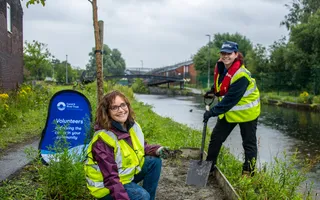Since I retired from being a university biologist ten years ago, I have been privileged to spend much of May to September each year walking along canal towpaths and recording water plants.
I find that walkers, boaters and people generally enjoying the canal ambiance are often interested in talking to a person wearing a Trust life jacket, clutching a notebook, and retrieving plant fragments with a grapnel or pole and hook. Often the people encountered know about plants from their interest in gardening or natural history, and we can learn from each other about plants that are found along the canals.
Working with professionals
The plant recording that I have done has only been possible with the help and support of the Trust's professional ecologists. They have provided historical and management data and have made helpful suggestions about canals to visit, and sites to survey, and we have sometimes made field visits together.
Jonathan Hart-Woods, Phillippa Baron, Imogen Wilde and Diane Rollin are amongst these. Trust ecologists, however, are very busy people and inevitably are constantly occupied by day-to-day tasks and administration. Unlike me, they do not have the luxury of days at a time to spend in the leisurely recording of plants.
Recording water plants
My recording of water plants has been mostly in Yorkshire canals, although I have strayed further afield to the Chesterfield, Cromford, Erewash, Grantham and Lancaster canals. In recent summers I have surveyed plants along most of Yorkshire's canals, over 200 lengths of canal, approaching 200km, have been surveyed. Waterways visited ranged from traditional canals, like the Leeds & Liverpool, to large-scale waterways like the Knottingley & Goole Canal, to derelict canals like the Barnsley Canal, and to restored waterways like the Huddersfield Narrow Canal.






